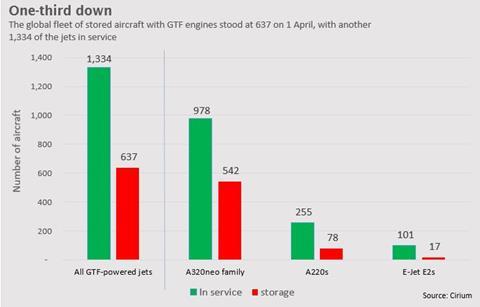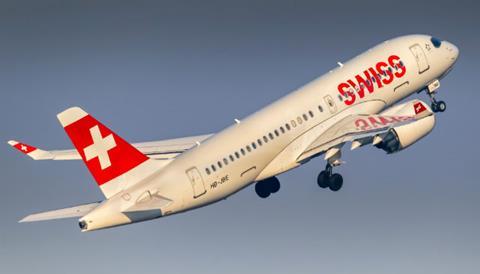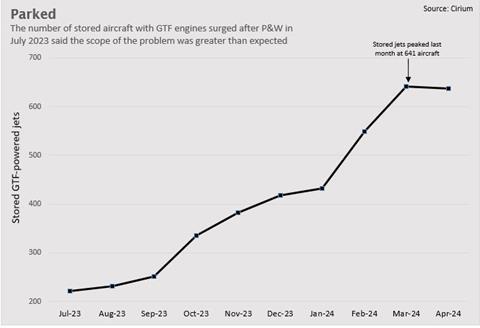Around three in every 10 jets powered by Pratt & Whitney’s PW1000G family of turbofans are now sidelined worldwide.
That is according to analysis of Cirium data, which reflects, though not perfectly, the extent to which airlines from all corners of the globe are finding their operations disrupted by P&W’s recall of its geared turbofan (GTF) engines.
P&W has said the number of jets parked due to the need for inspections and replacement engine parts will peak right about now, in the first half of 2024. The issue involves defects in metallic components introduced during a manufacturing process due to the use of contaminated powdered metal.
Cirium data shows that 637 jets with GTF engines were in storage on 1 April – 32% of the total fleet. The balance of 1,334 PW1000G-powered aircraft remain in active service.

The vast majority of the stored jets are PW1100G-powered A320neos and A321neos – 542 of those are parked, or 36% of that fleet. Another 78 PW1500G-powered A220s – 23% of that fleet – and 17 PW1900G-powered Embraer 190-E2s and E195-E2s, 14% of that total, are sidelined, Cirium data shows.
To be clear, Cirium does not specify that the jets are stored due to the powdered-metal manufacturing problem. It tags many of the stored jets as “Parked – technical issue”, but provides nothing more specific, meaning some are likely idled for other reasons.
P&W declines to comment or to say how many aircraft are currently out of service due to the GTF issue. It has previously said the issue will leave an average of 350 A320neo-family jets will out of service between 2024 and 2026.

Though firm figures are elusive, Cirium data provides a benchmark for comparison to other fleets powered by different engine types. It shows that only 53 A320neo-family aircraft using the competing CFM International Leap-1A turbofan are currently stored – just 3% of that fleet. A similar rate – 2% or 34 aircraft – can be seen with the Leap-1B-powered 737 Max.
That comparison illustrates the significant effect the GTF defect is having on airlines. Carriers have made no secret about the scale of the problem. Several have said that one-quarter or more of their GTF-engined aircraft have been sidelined, causing financial pressure and prompting then to curtail expansion plans, revamp operations and seek replacement jets in an incredibly tight market. Airlines are also negotiating multi-million-dollar compensation packages with P&W.

“The problem of our aircraft being unproductive is the fact [that] we are paying twice. We have aircraft investments unproductive on the ground, and we have to rent, wet-lease [aircraft from] another company to produce the capacity in the market,” Swiss chief executive Dieter Vranckx said during a 4 April event in Washington DC.
Swiss’s GTF-powered fleet includes 10 A320/A321neos and 35 A220s. But the carrier expects an average of 10-12 of those aircraft will grounded at any given time this year due to the engine issues, Vranckx says. In response, Swiss is backfilling some lost capacity by wet leasing aircraft and crews from carriers including Air Baltic and Helvetic Airways – though both also use GTF-powered jets. Nonetheless Vranckx insists the airline remains committed to the Airbus jets.
On the bright side, the number of parked GTF-powered jets decreased ever so slightly in the last month, from 641 on 1 March to 637 on 1 April, perhaps signalling a plateau. The data previously showed a steady increase in the number of grounded aircraft since P&W disclosed the problem’s wider implications in July last year.

The GTF issue is certainly not the only significant factor holding airlines back. Boeing in particular, and Airbus to a lesser degree, have been late delivering new jets, leaving airlines with fewer aircraft than planned.
The airframers have been hit by labour shortages and nagging supply chain problems. Boeing has also curtailed 737 Max production this year amid safety and quality concerns stemming from the 5 January in-flight loss of a Max 9’s door plug.
But the GTF issue is chief among many airlines’ frustrations.
Defective engine components include high-pressure turbine and compressor disks, compressor hubs and air seals, according to P&W and the Federal Aviation Administration, which has ordered maintenance fixes. The defects make the components less durable – more likely to fail. P&W, and then the FAA, became aware of the issue after a 2020 engine failure; another engine failed in 2022.
P&W’s response has been to recall the engines for inspections and replacement parts – work taking 250-300 days per unit.
Carriers from all corners of the globe have taken aircraft out of service as a result.
On 1 April, US discounter Spirit Airlines had 19 parked jets, Delta Air Lines had 14, Mexico’s Volaris had 30, Air China had 28, Japan’s ANA had 21, Egyptair had 10 and Vietnam Airlines had nine, according to Cirium data.
On 29 March, Spirit said P&W had agreed to compensate it to the tune of $150-200 million, warning the issue will force it to remove “nearly all” its A320neo-family jets from service at some point. That package equates to P&W paying Spirit about $18,000 daily per grounded aircraft, financial firm Jefferies said in a 1 April report.
Additional reporting by Ned Russell.



























